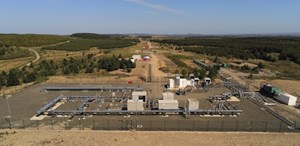News
DNV to support UK national gas transmission with H2 pipeline research facility
DNV is the lead partner for National Gas Transmission (NGT) in further expanding a world first H2 pipeline research facility FutureGrid. NGT was awarded two Strategic Innovation Funded (SIF) projects by OFGEM to research the suitability of existing assets to transport H2 in the current National Transmission System (NTS) as part of its FutureGrid project.
In 2021 DNV began construction of a high-pressure H2 test facility at its Spadeadam Research and Test Facility in Cumbria, Northern England, repurposing existing transmission assets, to demonstrate the NTS could transport H2 safely and reliably. The project, FutureGrid Phase 1, was commissioned in September 2023 and achieved a landmark of operating with 2% H2 blended with natural gas. The work continues with the aim of blending 100% H2 by the end of January 2024.
FutureGrid Phase 2: Compression, Deblending and Purification, is part of a strategic initiative for NGT and the first of many steps towards converting the existing NTS to transport H2. For Phase 2, DNV, along with other partners, is supporting NGT by developing a compression and pipeline test facility at Spadeadam. The facility will enable offline testing of the full compression system and provide evidence for a safe and cost-effective transition to H2.
DNV will support NGT in developing a H2 de-blending, purification, and refueling facility at the site. DNV will be responsible for designing, installing and operating the infrastructure. The facility will use the existing FutureGrid infrastructure already installed at Spadeadam.
The projects aim to provide the technical evidence gaps and gain a full understanding and knowledge of working with H2, to develop processes and procedures—like those NGT currently have for natural gas—to allow them to run a safe and reliable national H2 network.
Martin Cook, Commercial Director for National Gas said, “National Gas are proud to be leading the way with its groundbreaking research at FutureGrid, Spadeadam. Working alongside partners such as DNV will help us to understand how H2 can be transported in the current NTS. This is a critical step towards achieving the Government’s Net Zero targets for 2050, boosting energy resilience and increasing storage capacity as well as reducing emissions.”
Hari Vamadevan, Executive Vice President and Regional Director, UK & Ireland, Energy Systems at DNV said, “There is quite rightly much debate in the industry, media and society about the safety and cost implications of using H2 in the UK gas networks. DNV is pleased to be a key partner for NGT and deliver a world-class H2 test and demonstration facility for compression systems, that could provide the key evidence to transition the UK network. The project is a critical element for the energy transition in the UK as it looks to reach its legally binding net-zero goals by 2050.”
Gary Tomlin, Vice President, Laboratories and Testing, Energy Systems at DNV said, “At Spadeadam we have been involved with numerous H2 testing and research projects over many years for companies around the world. One of the areas which we will test at FutureGrid is H2 concentrations from 2%, 5%, 20% and 100%, operating at different flow rates in order to generate conditions seen on the NTS. Throughout the testing we will be concentrating on vibration, noise, and permeation across the facility. Leak monitoring will be completed across the facility and compared across the blends of gases.”
This project aligns with DNV’s recent research in its 2022 H2 Forecast to 2050 which highlights that cost considerations will lead to more than 50% of H2 pipelines globally being repurposed from natural gas pipelines. Repurposing pipelines can offer significant cost savings, with costs in the range of 10%–35% of new pipelines.
DNV has also issued a white paper “Repurposing onshore pipelines for H2: Guiding operators through the re-evaluation process” to look at the issue. This study, intended for both industry and regulators, explores current standards and challenges, and presents a new process to assess the safety and feasibility of repurposing natural gas pipelines for H2 based on rigorous evaluation.


